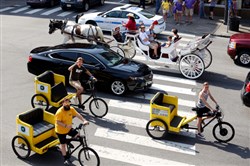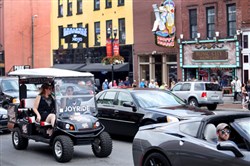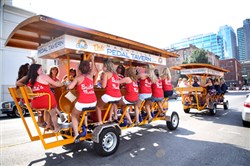VOL. 39 | NO. 31 | Friday, July 31, 2015
Pedal-powered vehicles, electric carts find open lane in downtown Nashville congestion
By Joe Morris
Time was, crossing Lower Broadway safely only meant dodging woozy country music fans, speeding cabs and the occasional errant tour bus.
They’re all still there, but they’ve been joined by a wide and growing variety of small-motor or human-powered vehicles shuttling residents and tourists in and around downtown Nashville.
Mercifully for those on foot, the new class of transportation isn’t likely to mow anyone down in a crosswalk. In fact, whether it’s a pedal cab, mobile tavern or tricked-out, low-speed cart, velocity is very much a secondary consideration.
“We’re more of a tour, and we’re only going about two miles an hour,” says Angie Gleason, general manager of Nashville Pedal Tavern, which has been allowing riders to sip and sightsee as they pedal their way around downtown.
“We seat 16 people and, as a group, they are enjoying drinking and talking with each other and looking around; we’re not trying to get them to any specific spot.”
Nashville Pedal Tavern has been in operation for five years, and now has 10 vehicles on the road. They follow a couple of specific routes around Broadway and in Midtown, as well as a brewery tour.

Nashville Pedicabs share Lower Broadway with horse-drawn carriages buggies and normal street traffic.
-- Michelle Morrow | The LedgerA SoBro route is in the offing, so that the company can capitalize on a fast-growing part of the city, as well as continue to expand its offerings to residents as well as tourists.
“In the last couple of years, we’re seeing a lot more locals,” Gleason says. “People will have families coming in and instead of them just booking us, they join their visitors as well. It’s a different way to see the city.
“We’re definitely seeing growth out from downtown, and so we hope to follow it into areas like south of the convention center, which is really going to blow up in the next couple of years.”
Rules of the road
Because of their low speed, the pedal taverns, as well as their non-alcoholic pedaling counterparts, don’t have to have seat belts, but they do have to have turn signals and other motor-vehicle accessories.
They also have to remain on streets with speed limits of 35 miles per hour or less.
They are overseen in part by Metro’s Transportation Licensing Commission, which regulates taxis, towing services and booting companies, as well as passenger-for-hire vehicles – anything from limousines to horse-drawn carriages.
The basics
How does Uber make money?
Uber, which operates in 250 cities in 50 countries, keeps 20 percent of every transaction. According to the Profit Confidential website and other sources, Uber’s gross revenue is expected to hit about $10 billion by the end of 2015.
Uber’s annual growth rate was in the 300 percent range in 2014 and is expected to be another 300 percent in 2015.
The company is considering allowing its fleet of drivers to transport goods and services.
What about Lyft?
Lyft, which was operating in 68 cities in March 2015, has a target of $1.2 billion in gross revenues this year, around $300 million net, according to techcrunch.com.
That’s based on a 20-25 percent commission for its rides.
What about the drivers?
SherpaShare, an app that helps ride-share drivers to track their mileage and income, reported last week that the average price per ride is highest in New York City. Drivers can expect to earn more than $28 for a single lift.
Nashville drivers for the two peer-to-peer ride sharing services are making $10.14 to $10.45 per ride.
SherpaShare’s findings are based on using driver-submitted data between January and May 2015. While the app was able to post the average price per ride in 20 major U.S. cities, it was unable to determine how much a driver could make per hour.
As more of these motorized and non-motorized vehicles have hit the streets in recent years, they have begun to appear more on the city’s radar in terms of route regulation and more, says Billy Fields, the commission’s director.
“Some members of the Metro Council have asked us to consider regulating the pedal and low-speed vehicles, but they already have to meet quite a few regulations,” Fields explains.
“To be classified as “low speed,” they must be able to go at least 20 miles an hour, and no more than 25, for instance. And they have to carry $1 million in per-incident insurance. The drivers have to be licensed and go through a background check.”
As to the pedal and motorized vehicles themselves, which includes such operators as Nashville Pedicab – they’re the ones that look like rickshaws – and Joyride, which resemble golf carts, they must have a horn, rear-view mirrors, disc or drum brakes, turn signals, headlights and, yes, seat belts.
“The pedal vehicles don’t require seat belts because they are going really slow, but they do have to have reflectors and other safety measures,” Fields notes. “But all of them have to go through our process, and then they are issued certificate of public convenience and necessity, which is the same for motorized and non-motorized vehicles.
“That’s different than what a cab is issued, because these vehicles are more for entertainment than actually getting someplace.”
Quick hops
However, a short hop between points A and B is exactly what Joyride has in mind, and in the past two years the company has worked to become the fast-shuttle operator of choice in the downtown area, says Grant Rosenblatt, COO.

Electric carts providers such as Joyride have changed downtown’s transportation landscape.
-- Michelle Morrow | The Ledger“When we started we were looking at tourism, but our big thing has been to create a new industry, micro transportation, which is the quick rides that regular cabs and apps like Lyft and Uber don’t really service,” Rosenblatt says.
“They are less than two miles, and are so quick that there’s no money to be made, but because we’re a tip-base service we can do 40 or 50 of these every day. The hospitality industry sees the value and has really welcomed us, as have locals who live or work downtown.”
A ride can be arranged by calling in and having a vehicle dispatched, using an app that’s about to be released or just by hailing one down on the street. Joyride keeps a facility near Second Avenue and Peabody Street for its 32-vehicle fleet, which Rosenblatt touts as the largest low-speed armada of its kind in the country.
Plans are in the works to expand to Knoxville and other cities, and to continue monetizing the company by branding the vehicles and allowing drivers to talk about those products.
“In the three to five minutes you’re with us, you might hear about a company, restaurant or brand, and maybe even get a product sample,” Rosenblatt says. “The ride is free, but while we’ve got your attention we talk about something.
“But at the same time, you’re meeting a fun, friendly driver who’ll give you his or her cell phone so that you can call for another ride, and it’s a fun experience.”
Horse and buggy
All this zipping around has certainly gotten the attention of Sugar Creek Carriages’ Johnny Smith, who along with wife Brenda has been providing horse-drawn carriage tours in Nashville for 15 years.
“They’re cutting into our business some, but we all get along,” Smith says. “As long as the commissions and city officials keep it fair in terms of the rules and regulations, I think we’ll all be OK.
“It’s a fair market, and there’s no reason why they shouldn’t all do well here. We all offer different things, and so we’ll draw in different people.”’
At the moment, however, Smith says the horses have a set route they must follow, while the pedal cabs, taverns and low-speed vehicles have a little more leeway. He would like to see some parity in that regard.
“They get to run at some times, like rush hour, when we can’t operate, and they don’t have the boundaries that we do, so we would like to see them have some of the same rules we do,” Smith adds.

Bridesmaids and friends enjoy The Nashville Pedal Tavern along with drinking, talking and sight seeing all while pedaling to get around.
-- Michelle Morrow | The Ledger“All of us are good for Nashville, we just want to make sure that everybody’s got a level playing field.”
Specific zones for pedal and low-speed vehicles may be coming, Fields says, and that would be a process involving the Transportation Licensing Commission along with the Traffic and Parking Commission.
And like all regulatory endeavors, it would take a while and be open to pubic scrutiny and comment.
“We did set those zones for the horses and carriages, and the authority is there to establish them for these other conveyances,” Fields explains.
“They’ve been around long enough now that we have a baseline to study in terms of their numbers and operations, and so now we can have hearings, and get some proposals ready for public input and comment around zones and operating areas. After that’s done, and if everything is approved, then we would change the ordinance.”
That activity will likely take place this fall, he adds, nothing that all the companies involved will have plenty of time to weigh in.
“They are all very popular, or they wouldn’t be here,” Fields says. “Our goal is just to make sure that everyone is operating properly and safely.”
Uber, Lyft get state-level clarity
Those in need of a more conventional ride also continue to turn to Lyft and Uber, both of which continue to do a brisk business in Nashville.
Of the two, Uber seems to have a more visible presence in the market. Since beginning service in early 2014, the company has rolled out four types of service, as well as opening a local office with six corporate employees.
Both provide service by connecting potential riders to drivers through their mobile apps, and have agreed to abide by regulations that were put in place by Metro in late 2014 that created a new category of passenger vehicles, the TNC (transportation network company) vehicle.
These are app-based, personal-use cars, according to the Transportation Licensing Commission, which had been set to levy an annual fee on the companies.
However, in early 2015 the Tennessee General Assembly passed regulation that exempted Uber and Lyft from local regulations while putting in place state rules and regulations that include third-party local and national background checks and a zero-tolerance policy for driving under the influence.
The bill also contained insurance guidelines.
Cab drivers continue to be riled by Uber and Lyft, in large part because there currently is no limit on TNC permits, while regular taxi permits are capped.
These days, Uber is battling on many fronts to keep its drivers as independent contractors vs. employees, and the outcome could affect its many Nashville drivers.